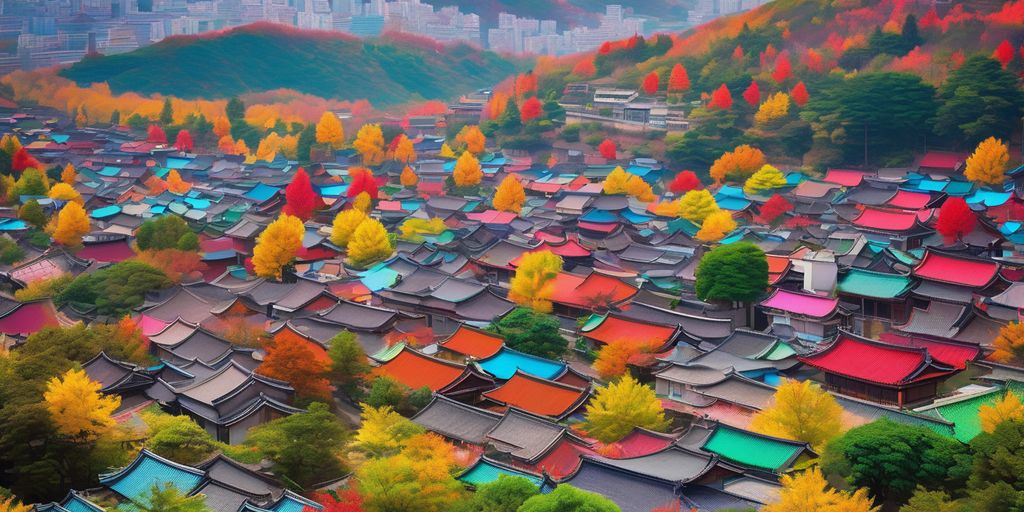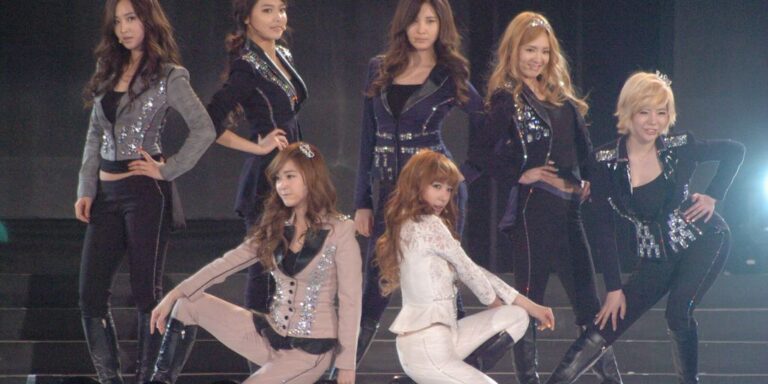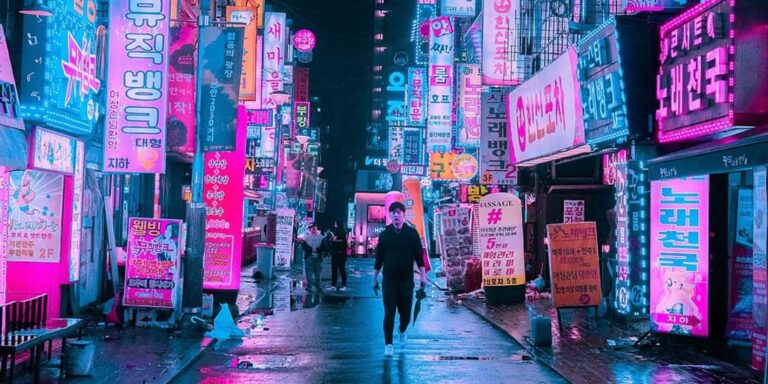
South Korea, a country where ancient tradition meets modern innovation, offers a plethora of experiences that range from the bustling urban landscapes of Seoul to the tranquil natural beauty of Jeju Island. This article, ‘Korea Chronicles: Captivating Landscapes and Vibrant Cities’, ventures through various regions, highlighting their unique attributes and experiences. Whether it’s the historical depth of Cheongju or the artistic vibrancy of Seoul, each location promises a unique journey into the heart of Korean culture.
Key Takeaways
- Discover Seoul’s rich tapestry of street art and historical palaces, showcasing a city where past and present coexist.
- Explore Jeju Island’s pristine beaches and volcanic landscapes, offering a glimpse into South Korea’s stunning natural beauty.
- Experience Busan’s dynamic blend of traditional markets and modern cultural festivals, illustrating the city’s diverse attractions.
- Uncover Cheongju’s historical and natural wonders, from ancient fortresses to vibrant cultural markets.
- Navigate South Korea’s efficient public transit system, connecting diverse regions with ease and promoting eco-friendly travel.
Exploring Seoul: A City of Infinite Discoveries
Street Art and Urban Canvas
Seoul, a city vibrant with culture and creativity, offers a treasure trove of street art that transforms urban spaces into dynamic canvases. Explore neighborhoods like Hongdae for dynamic street art scenes, and Insadong for a blend of traditional and contemporary art galleries. Each piece of street art in Seoul not only beautifies the city but also tells a unique story, reflecting the city’s modern pulse and artistic diversity.
Historical Palaces and Modern Life
Seoul harmoniously blends its rich historical heritage with the demands of modern life. The city’s historical palaces stand as testaments to its deep-rooted history, surrounded by the bustling modern cityscape. This juxtaposition offers a unique cultural experience, where ancient architecture meets contemporary urban life, providing a captivating backdrop for both residents and visitors.
Public Art as a Catalyst for Urban Revitalization
Public art in Seoul serves not just as decoration but as a catalyst for urban revitalization. Engaging with the city’s public art can be a deeply enriching experience, whether you’re an art enthusiast or a curious traveler. Recommended walking tours and neighborhoods provide structured paths to explore this artistic journey, enhancing the overall experience of the city’s cultural landscape.
Jeju Island: South Korea’s Natural Paradise
Jeju Island, nestled in the Yellow Sea, is a subtropical paradise renowned for its pristine beaches, crystal-clear waters, and unique volcanic landscapes. The island is not only a haven for beach lovers but also a hub for diverse adventures. From the challenging hikes up Hallasan to surfing at Woljeongri Beach and exploring the mysterious Geomunoreum Lava Tube System, Jeju offers a plethora of activities for every type of adventurer.
Pristine Beaches and Volcanic Landscapes
Jeju’s southern shores, such as Seopjikoji and Hyeopjae Beach, are celebrated for their scenic beauty and tranquil atmosphere. The island’s volcanic craters and rugged terrain provide a dramatic backdrop for outdoor activities and nature photography. During spring, the cherry blossoms at Jeonnong-Ro and Halla Arboretum offer a breathtaking spectacle, making it a perfect time for a visit.
Cultural Heritage and Local Cuisine
Jeju’s rich cultural heritage is deeply intertwined with its local cuisine. Traditional dishes like Jeonbokjuk (abalone porridge) and Haemul Pajeon (seafood pancake) reflect the island’s maritime culture. Visitors can explore local markets and experience the vibrant culinary scene. Samseonghyeol Shrine and other historical sites offer a glimpse into the island’s past, providing a cultural depth to the travel experience.
Eco-Tourism and Adventure Activities
Jeju is a leader in eco-tourism, offering sustainable travel experiences that range from guided nature walks to eco-friendly resorts. Adventure seekers can indulge in activities like paragliding, horseback riding, and scuba diving. The island’s commitment to preserving its natural and cultural resources ensures a responsible yet thrilling exploration for all visitors.
Busan: A Blend of Tradition and Modernity
Vibrant Markets and Coastal Beauty
Busan, South Korea’s bustling port city, offers a unique blend of vibrant markets and stunning coastal scenery. The Jagalchi Fish Market, the largest seafood market in Korea, provides a sensory overload with its lively atmosphere and fresh catches. Nearby, Haeundae Beach offers a tranquil escape with its soft sands and clear waters.
Historical Temples and Urban Culture
The city’s rich history is showcased through its numerous temples, such as the Beomeosa Temple, nestled in the mountains. These sacred sites offer a peaceful contrast to the urban energy of Busan’s modern cityscape. The blend of historical depth with contemporary vibrancy makes Busan a fascinating destination for cultural enthusiasts.
Film Festivals and Culinary Delights
Busan is renowned for hosting the prestigious Busan International Film Festival, attracting cinephiles from around the globe. The city’s culinary scene is equally impressive, featuring both traditional Korean dishes and innovative cuisine. Sampling the local fare, particularly the seafood, is a must for any visitor.
Cheongju: A Tapestry of History and Nature
Cheongju, a city where history and nature converge, invites you on a journey through its timeless marvels. From the historic Sangdang Sanseong Fortress to the vibrant Yukgeori Market, each attraction adds a unique layer to Cheongju’s diverse identity. Embrace the city’s cultural and natural wonders, create lasting memories, and let Cheongju be a vibrant chapter in your South Korean travel story.
Sangdang Sanseong Fortress
Steeped in history, Sangdang Sanseong Fortress stands as a testament to Cheongju’s ancient past. The fortress, perched on a hill, offers panoramic views of the city and the surrounding landscapes. Visitors can wander through the well-preserved walls and gates, immersing themselves in the stories of Cheongju’s bygone eras.
Yukgeori Market
Welcome to Yukgeori Market, a bustling hub where tradition meets modernity. Here, visitors can explore a myriad of stalls featuring local crafts, fresh produce, and traditional Korean delicacies. This market is not just a place for shopping; it’s a vibrant arena of cultural exchange and a window into the daily lives of the Cheongju people.
Cultural Festivals and Local Crafts
Cheongju is home to a variety of cultural festivals that celebrate its rich heritage and vibrant community spirit. These events offer a platform for local artisans to showcase their skills in traditional crafts and design. Visitors can experience the warmth of Cheongju’s community through these engaging and colorful festivities, making their visit truly memorable.
The Artistic Pulse of South Korea
Contemporary Art Scenes
South Korea’s contemporary art scene is a vibrant tableau of creativity and innovation. Galleries and museums across the country showcase cutting-edge works that reflect both global trends and unique local insights. Seoul, in particular, is a hub for contemporary art, with numerous spaces dedicated to both established and emerging artists.
Traditional Crafts and Design
The rich tapestry of traditional Korean crafts and design continues to thrive in modern South Korea. Artisans meticulously preserve techniques in pottery, textile, and metalwork, which are often showcased in markets and exhibitions. These crafts not only embody centuries of cultural heritage but also adapt to contemporary aesthetics and functionalities.
Innovative Art Festivals
South Korea hosts a variety of art festivals that serve as platforms for artistic expression and cultural exchange. These events range from large-scale international biennales to local art fairs that highlight the diversity of Korean art. Festivals often incorporate interactive elements and multimedia installations, making art accessible and engaging for a broad audience.
Navigating South Korea’s Efficient Transit System
South Korea’s public transit system is a marvel of efficiency and connectivity, making it a breeze for tourists and locals alike to explore the country’s natural wonders and cultural treasures. From high-speed trains to eco-friendly buses, the options are both convenient and sustainable.
Seamless Connections Between Cities
The transit network in South Korea is designed for ease of travel between major cities and tourist attractions. High-speed trains like the KTX connect Seoul to Busan in just under three hours, demonstrating the system’s efficiency and the government’s commitment to reducing travel time.
Accessibility and Tourist-Friendly Services
South Korea’s transit system is not only fast but also accessible. Stations are equipped with English signs and tourist help desks, making navigation simple for international visitors. Additionally, apps and websites provide real-time updates and travel tips, ensuring a smooth journey.
Eco-Friendly Transportation Options
The commitment to sustainability is evident in South Korea’s transportation choices. Many buses and public transport vehicles are now powered by eco-friendly fuels, and bike-sharing programs in major cities encourage less reliance on motor vehicles, aligning with global environmental goals.
The K-Pop Phenomenon: More Than Music
Concerts and Fan Culture
K-Pop concerts are not just musical events; they are grand spectacles that showcase elaborate choreography, stunning visuals, and fan interactions that are deeply embedded in the culture. Fans, known as ‘idols’, play a crucial role, participating in fan chants and light shows, creating an electrifying atmosphere.
Influence on Global Fashion
K-Pop has significantly influenced global fashion, introducing the world to vibrant styles and trends that resonate with youth culture. From oversized clothes to bold accessories, K-Pop stars set fashion trends that fans and fashionistas globally emulate.
Integration with Traditional Korean Music
K-Pop seamlessly integrates traditional Korean music elements, such as ‘gugak’, into its tracks. This fusion not only preserves but also promotes Korean cultural heritage, making it accessible to a global audience. The blend of modern and traditional sounds is a testament to the genre’s versatility and its role in cultural diplomacy.
Conclusion
South Korea, a land of captivating landscapes and vibrant cities, offers a unique blend of natural beauty and urban sophistication. From the tranquil shores of Jeju to the bustling streets of Seoul, each location tells a story of cultural richness and innovative spirit. Whether you’re exploring ancient temples or experiencing the dynamic world of K-pop, South Korea invites you to immerse yourself in its diverse offerings. The country’s efficient public transit system ensures that these treasures are easily accessible, making it a perfect destination for adventurers and culture enthusiasts alike. As you journey through South Korea, let its myriad of experiences enrich your travels and leave you with unforgettable memories.
Frequently Asked Questions
What are some must-visit attractions in Seoul?
Seoul offers a variety of attractions including Gyeongbokgung Palace, vibrant street art in various neighborhoods, and dynamic public art installations that transform the cityscape.
Can you describe the natural beauty of Jeju Island?
Jeju Island is renowned for its pristine beaches, volcanic landscapes like Hallasan Mountain, and lush greenery, making it a paradise for nature lovers and eco-tourists.
What makes Busan a unique destination in South Korea?
Busan combines traditional Korean culture with modernity, featuring bustling markets, beautiful coastal areas, and a rich array of cultural festivals and events.
What are some cultural highlights in Cheongju?
Cheongju is famous for its historical sites like Sangdang Sanseong Fortress, vibrant Yukgeori Market, and numerous cultural festivals that celebrate local crafts and traditions.
How does the public transit system enhance travel in South Korea?
South Korea’s efficient public transit system offers seamless connections between major cities, making it easy for tourists to explore the country’s diverse attractions comfortably and sustainably.
What impact has K-Pop had on South Korea and globally?
K-Pop has not only reshaped the music scene in South Korea but has also influenced global fashion, integrated traditional Korean music, and fostered a unique fan culture worldwide.




Leave a Comment